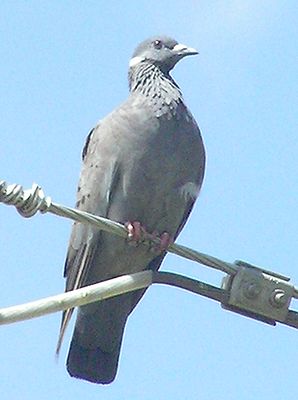Amharic pigeon
| Amharic pigeon | ||||||||||
|---|---|---|---|---|---|---|---|---|---|---|

Amharic Pigeon ( Columba albitorques ) |
||||||||||
| Systematics | ||||||||||
|
||||||||||
| Scientific name | ||||||||||
| Columba albitorques | ||||||||||
| Rüppell , 1837 |
The Amharentaube ( Columba albitorques ), also called the Abyssinian rock pigeon , is a species of pigeon birds. It occurs exclusively in Africa.
Appearance
The amharic pigeon reaches a body length of 30 centimeters. It is roughly the size of a small city pigeon. There is no gender dimorphism.
The plumage of the amharic pigeon is predominantly dark slate gray. It has white hand covers, which are not visible when the wings are closed. Characteristic of this species is the striking, pure white neck band that extends from ear to ear. The wax skin is light. The beak is deep dark gray. The iris is dark red. The legs and feet are reddish.
distribution and habitat
The Amharentaube has a relatively small distribution area. It occurs only in the rocky highlands of Ethiopia . There their distribution area extends from the south of Eritrea to the Jima and Arussi mountains. It is a common pigeon species within this limited range. The altitude distribution of this species ranges from 1,800 to 4,000 meters above sea level.
Within the distribution area the Amharentaube uses a number of different mountain habitats. It prefers to live on grasslands, cultivated land, and open forests near ravines and human settlements. It has also opened up human settlement areas and is also found in the interior of larger cities.
Way of life
The Amharentaube lives individually, in pairs or in small groups. Larger swarm gatherings can occur at their resting places and on the feeding grounds. There it is often associated with the Guinea pigeon. The resting places can be found on cliffs and on buildings. These are left in the morning to go to the feeding grounds. The food spectrum includes cereals and other seeds. The nest is built in crevices or similar openings in buildings. The clutch comprises two eggs. The breeding season is 16 days. The young birds fledge after 27 to 31 days.
supporting documents
Individual evidence
literature
- David Gibbs, Eustace Barnes and John Cox: Pigeons and Doves - A Guide to the Pigeons and Doves of the World . Pica Press, Sussex 2001, ISBN 90-74345-26-3 .
- Alois Münst and Josef Wolters: Tauben - The species of wild pigeons , 2nd expanded and revised edition, Verlag Karin Wolters, Bottrop 1999, ISBN 3-9801504-9-6 .
- Gerhard Rösler: The wild pigeons of the earth - free living, keeping and breeding . Verlag M. & H. Schaper, Alfeld Hannover 1996, ISBN 3-7944-0184-0 .
Web link
- Columba albitorques inthe IUCN 2013 Red List of Threatened Species . Listed by: BirdLife International, 2012. Retrieved October 3, 2013.